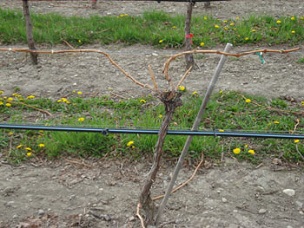
A cane-pruned vine
The
first step in pruning is to identify the fruiting canes for next year.
Desirable fruiting canes develop under conditions of good sunlight
exposure, which is a function of the training system, last season’s
pruning level, and canopy management practices. Good sunlight exposure
promotes bud fertility and wood maturity. Select fruiting canes and
renewal spurs from positions close to the trunk head to prevent the
arms from becoming too long, which will cause a nonproductive gap in
the canopy above the head. The characteristics of desirable fruiting
canes are:
1. Firm wood with brown periderm
nearly to the tip; a sufficient number of healthy, fruitful buds; and
no mechanical damage or visible disease infections.
2. Round in cross-section with relatively short internodes (3 to 4
inches) and moderate diameter (1/4 to ½ inch).
3. Well positioned (i.e., arising close to the trunk).
After
selecting good fruiting canes (either one or two depending on the
training system and vine spacing), select another good, well-positioned
cane as a renewal spur and prune back to one or two buds. Periodically,
you may want to retain a watersprout (during shoot thinning) closer to
the trunk than the current renewal spur. At the next dormant pruning,
the watersprout cane becomes the renewal spur. This practice keeps arm
length from becoming excessively long. If the vineyard is
double-trunked, leave a cane and a renewal spur on each trunk.
An
alternate method does not retain a separate renewal spur. Instead, it
is assumed that in the next dormant season, a good basal cane from last
season’s fruiting cane can be selected as the new fruiting cane. Remove
the remainder of last year’s fruiting wood and all other extraneous
canes, including suckers and watersprouts. Trace the suckers back to
their source and cut them back completely to remove all basal buds.
Trim the fruiting canes to a length that retains the desired number of
dormant buds, then make the pruning cut through the next node (bud)
beyond the retained buds, so the enlarged portion of the node prevents
the tie from slipping off. Next, remove all tendrils and laterals, bend
the cane up onto the fruiting wire, wind it around one time, and
finally tie at the end.
If wood diseases are a high risk, all prunings should be removed from the vineyard and disposed of away from the vineyard.
Reviewed by Eric Stafne, Mississippi State University and Sara Spayd, North Carolina State University